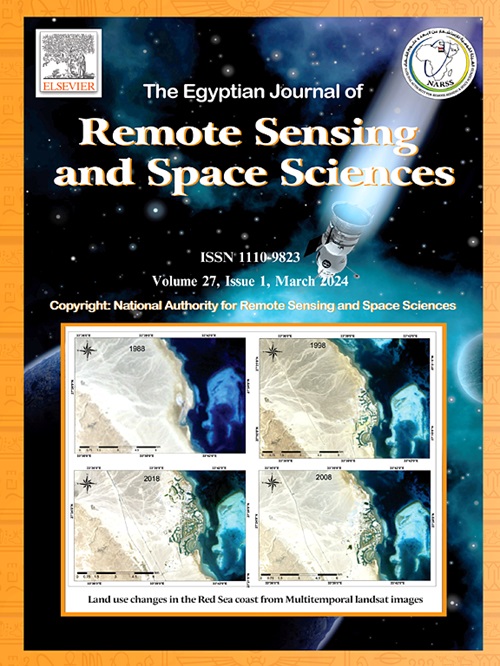Assessing water quality of a lake using combination of drone images and artificial intelligence models
IF 3.7
3区 地球科学
Q2 ENVIRONMENTAL SCIENCES
Egyptian Journal of Remote Sensing and Space Sciences
Pub Date : 2025-07-08
DOI:10.1016/j.ejrs.2025.07.001
引用次数: 0
Abstract
Lakes serve as a source of water to meet the demand of various sectors such as urban, agricultural and recreational sectors. The purpose of this paper is to investigate the capability of using combination of multispectral drone imagery with machine learning algorithm for the assessment of water quality in an artificial lake at the Jordan University of Science and Technology (JUST) campus. Several images with different resolutions under different wavebands were captured with DJI Phantom-4 drone equipped with sensors in the blue green, red, Red Edge, and Near Infrared. At the same time water samples were also collected from ten different points in the lake to analyze physical and chemical quality parameters. The spectral reflection was used to calculate multiple water body indices, and the resulting indices were correlated to water quality parameters. The indices with coefficient of determination greater than 0.7 were used to develop various artificial intelligence models (AI) such as Support Vector Machine (SVM), Random Forest (RF), Decision Tree (DT), Gradient Boosted Decision Trees (GBDT), Generalized Linear Model (GLM) and Artificial Neural Network (ANN). The results showed that among the tested models autoregressive with exogenous (NARX) ANN model has the highest prediction accuracy based on the coefficient of determination (R2) of 0.95 and relative error of 0.034. Comparison of the simulated results indicated the variability of water quality parameters with seasons and inversion accuracy was highest during the summer season. Such an approach offers a useful tool for decision-making to manage lake water quality. Future studies should include more parameters and using hyperspectral sensors for investigating quality parameters of similar water bodies.
结合无人机图像和人工智能模型对湖泊水质进行评估
湖泊是满足城市、农业和娱乐等各个部门需求的水源。本文的目的是研究将多光谱无人机图像与机器学习算法相结合用于约旦科技大学(JUST)校园人工湖水质评估的能力。大疆幻影-4无人机搭载蓝绿、红、红边、近红外传感器,在不同波段拍摄了多幅不同分辨率的图像。同时,从湖泊的10个不同地点采集水样,分析其理化质量参数。利用光谱反射计算多个水体指数,并将所得指数与水质参数进行关联。这些决定系数大于0.7的指标被用于开发支持向量机(SVM)、随机森林(RF)、决策树(DT)、梯度增强决策树(GBDT)、广义线性模型(GLM)和人工神经网络(ANN)等各种人工智能模型。结果表明,自回归外生(NARX)神经网络模型预测精度最高,决定系数(R2)为0.95,相对误差为0.034。模拟结果表明,夏季水质参数的季节变异性和反演精度最高。该方法为湖泊水质管理的决策提供了有用的工具。未来的研究应包括更多的参数,并利用高光谱传感器来研究类似水体的质量参数。
本文章由计算机程序翻译,如有差异,请以英文原文为准。
求助全文
约1分钟内获得全文
求助全文
来源期刊
CiteScore
8.10
自引率
0.00%
发文量
85
审稿时长
48 weeks
期刊介绍:
The Egyptian Journal of Remote Sensing and Space Sciences (EJRS) encompasses a comprehensive range of topics within Remote Sensing, Geographic Information Systems (GIS), planetary geology, and space technology development, including theories, applications, and modeling. EJRS aims to disseminate high-quality, peer-reviewed research focusing on the advancement of remote sensing and GIS technologies and their practical applications for effective planning, sustainable development, and environmental resource conservation. The journal particularly welcomes innovative papers with broad scientific appeal.

 求助内容:
求助内容: 应助结果提醒方式:
应助结果提醒方式:


